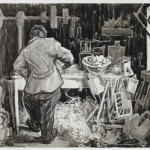Friday August 9, 1929. Literarishe Bleler. Page 12. The original document is written in Yiddish. This translation done by Khane-Faygl Turtletaub for the Rynecki family.
The Exhibition of Drawings and Graphics in the Jewish Art Society
The graphic arts have long been an independent branch of the plastic [arts?]. Nevertheless , the graphic artist’s works never played such a large role until now. In addition, the rapid development was caused by technology, modern advertising, [and] new machine printing. The graphic arts are actually the latest expression of current democratic times.
The graphic artist doesn’t have the rich color palette that the painter has, but the graphic artist, nevertheless, succeeds in getting out of the two black and white tones the secret lines that effects us as strongly as the colorful pictures.
[Paraphrasing]
The graphic artists have many technical means at their disposal. [3 artists are mentioned]
This is the first time that the Jewish art society put together an exhibition of drawings and graphics.
It is not especially rich in exhibited graphic works. The Polish-Jewish artists specialized very little in the field of graphics
Adan Hershaft is a good water-colorist.
Yegena Mundlakh has good technique and good lines. The paintings ‘A laughing Boy” and “A Boy” are quite realistic.
M. Pintsky has 6 pictures in the exhibition. He draw well, knows his craft and has a good sense of composition.
M. Shifman’s look like poorly copied things.
Trefler’s linoleum cuts show dynamism and movement.
H. Goldber’s book cover illustrations show good taste and an understanding of composition.
B. Rabinovitsh’s pictures show a lot of expression.
Tinovyetsky’s graphic works cannot be missed. Some flowers are subtle and some pictures show lots of expression. “The Invalid” is a strong satire of post was society.
Tikatshinsky is making good progress. He works in black and white, but his pictures show much delicacy. One picture shows good composition, another is consistent in stylization.
Kominsky deserves a special place among the Polish-Jewish artists. His book covers are very interesting. He works with a light hand and uses geometric shapes.
The cover of the book “Cement” must, without a doubt, be considered the most interesting covers in the book marketplace.
By Bem-Tsion Grinboym

